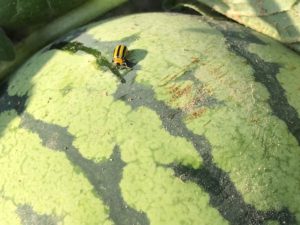Striped cucumber beetle can be a significant pest in watermelon production systems. These pests can cause feeding damage to roots, stems, leaves, and flowers of plants as well as the watermelon fruit itself (Figure 1). In large enough densities, this damage can lead to economic loss. The economic threshold for striped cucumber beetles in watermelon has been set at 5 beetles per plant, since they are not susceptible to bacterial wilt. When densities of the beetles reach this level, growers should treat their fields with an insecticide to avoid yield loss. To make good decisions, pest densities should be determined with scouting.
To investigate the pressure of striped cucumber beetles on commercial watermelon fields in Indiana we worked with 16 growers during the summers of 2017-18. Fields ranged in size from less than half an acre to 100 acres. The growers used a variety of management strategies and insect scouting programs. This diversity of strategies among growers provided the opportunity to better understand the impact of striped cucumber beetles, the effectiveness of management, and grower management decisions. Over the two years of the study, beetles were sampled on plants weekly until flowering and bi-weekly thereafter, to assess densities. The average number of beetles per plant was calculated for each sampling date.
During the two-year study, a total of 5,000 individual plants were sampled across 30 fields. No individual field ever reached threshold. A variety of management tactics were used by this diverse group of growers, and all of them maintained the population density at low levels. Even the one organic field never reached the threshold, suggesting that much of the insecticide use by conventional growers was unnecessary. Fewer applications will reduce exposure to pollinators in the system and reduce input costs for the crop. The data presented in the previous article suggests that applying too many insecticides can result in reduced yields. These results are similar to those found in muskmelons several years ago. Yield tends to be the highest when fields are scouted and only treated when the threshold is reached.
We have developed a scouting plan that will effectively detect beetles in densities of 2-4 per plant with 75% confidence which is typical of scouting protocols. We recommend sampling between 8 and 15 randomly selected plants across the field on a weekly basis until flowering and bi-weekly thereafter. To do this, count beetles on 8-15 plants scattered around the field. An effective means of sampling can be to use transects which sample four plants at set distances that span the field; repeat transects at different locations to reach the desired number of plants scouted. If the average is 5 beetles/plant or greater, an insecticide should be applied. If densities are approaching threshold, fields should be scouted more frequently. In most fields, scouting will only take about 20- 45 minutes depending on number of plants sampled (8 or 15). The use of scouting information and thresholds can reduce insecticide use (cost), lower pollinator exposure to pesticides, and potentially increase yields.
